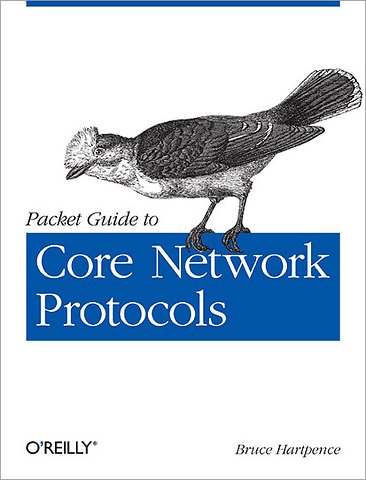Packet Guide to Core Network Protocols
Samenvatting
Take an in-depth tour of core Internet protocols and learn how they work together to move data packets from one network to another. With this updated edition, you’ll dive into the aspects of each protocol, including operation basics and security risks, and learn the function of network hardware such as switches and routers. New chapters examine the transmission control protocol (TCP) and user datagram protocol in detail.
Ideal for beginning network engineers, each chapter in this book includes a set of review questions, as well as practical, hands-on lab exercises.
You’ll explore topics including:Basic network architecture: how protocols and functions fit togetherThe structure and operation of the Ethernet protocolTCP/IP protocol fields, operations, and addressing used for networksThe address resolution process in a typical IPv4 networkSwitches, access points, routers, and components that process packetsTCP details, including packet content and client-server packet flowHow the Internet Control Message Protocol provides error messages during network operationsHow network mask (subnetting) helps determine the networkThe operation, structure, and common uses of the user datagram protocol
Specificaties
Inhoudsopgave
Preface;
Audience;
Contents of This Book;
Conventions Used in This Book;
Using Code Examples;
Safari® Books Online;
How to Contact Us;
Content Updates;
Acknowledgments;
Chapter 1: Networking Models;
1.1 What Is a Model?;
1.2 Why Use a Model?;
1.3 OSI Model;
1.4 Introducing TCP/IP;
1.5 Reading;
1.6 Summary;
1.7 Review Questions;
1.8 Review Answers;
1.9 Lab Exercises;
Chapter 2: Ethernet;
2.1 Remember the Models;
2.2 Structure;
2.3 Ethernet Type II vs. 802.3;
2.4 MAC Addresses—Another Look;
2.5 Ethernet Operation;
2.6 Shared Media;
2.7 Physical Layer;
2.8 Encoding;
2.9 Other Types of Signaling;
2.10 Topologies;
2.11 Final Thoughts on Ethernet;
2.12 Reading;
2.13 Summary;
2.14 Review Questions;
2.15 Review Answers;
2.16 Lab Exercises;
Chapter 3: Internet Protocol;
3.1 Protocol Description;
3.2 Structure;
3.3 Addressing;
3.4 Operation;
3.5 Digging a Little Deeper...What Addressing is Sufficient?;
3.6 Security Warning;
3.7 Organizations for Assigning Addresses and Names;
3.8 Standards and RFCs;
3.9 Summary;
3.10 Review Questions;
3.11 Lab Exercises;
Chapter 4: Address Resolution Protocol;
4.1 The Problem;
4.2 Techniques;
4.3 Protocol Description;
4.4 Structure;
4.5 Addressing in the ARP Request;
4.6 Addressing in the ARP Reply;
4.7 Operation;
4.8 Additional Operations;
4.9 Security Warning;
4.10 IPv6;
4.11 Digging a Little Deeper;
4.12 Standards and RFCs;
4.13 Summary;
4.14 Review Questions;
4.15 Review Answers;
4.16 Lab Activities;
Chapter 5: Network Equipment;
5.1 Tables and Hosts;
5.2 Hubs or Repeaters;
5.3 Switches and Bridges;
5.4 Access Points;
5.5 Routers;
5.6 Multilayer Switches and Home Gateways;
5.7 Security;
5.8 Summary;
5.9 Review Questions;
5.10 Review Answers;
5.11 Lab Activities;
Chapter 6: Internet Control Message Protocol;
6.1 Structure;
6.2 Operations and Types;
6.3 Digging a Little Deeper—the One’s Complement;
6.4 IPv6;
6.5 Summary;
6.6 Additional Reading;
6.7 Review Questions;
6.8 Review Answers;
6.9 Lab Activities;
Chapter 7: Subnetting and Other Masking Acrobatics;
7.1 How Do We Use the Mask?;
7.2 What Is a Subnet?;
7.3 Subnet Patterns;
7.4 Subnet IP Addressing;
7.5 A Shorthand Technique;
7.6 The Effect on Address Space;
7.7 Theory vs. Reality;
7.8 Supernetting;
7.9 The Supernetted Network;
7.10 Classless Inter-Domain Routing;
7.11 CIDR and Aggregation Implementation;
7.12 Summary;
7.13 RFCs and Reading;
7.14 Review Questions;
7.15 Review Answers;
7.16 Lab Activities;
Chapter : Internet Protocol Version 6;
8.1 Protocol Description;
8.2 Structure;
8.3 Extensions;
8.4 Addressing;
8.5 IPv4 and IPv6;
8.6 Multicast;
8.7 MAC Addressing;
8.8 Anycast;
8.9 Unspecified;
8.10 Required Addresses;
8.11 Auto-configuration;
8.12 Tunneling;
8.13 Current Status and IPv6 Day;
8.14 Summary;
8.15 Reading;
8.16 Review Questions;
8.17 Review Answers;
8.18 Lab Activities;
Colophon;
Net verschenen
Rubrieken
- aanbestedingsrecht
- aansprakelijkheids- en verzekeringsrecht
- accountancy
- algemeen juridisch
- arbeidsrecht
- bank- en effectenrecht
- bestuursrecht
- bouwrecht
- burgerlijk recht en procesrecht
- europees-internationaal recht
- fiscaal recht
- gezondheidsrecht
- insolventierecht
- intellectuele eigendom en ict-recht
- management
- mens en maatschappij
- milieu- en omgevingsrecht
- notarieel recht
- ondernemingsrecht
- pensioenrecht
- personen- en familierecht
- sociale zekerheidsrecht
- staatsrecht
- strafrecht en criminologie
- vastgoed- en huurrecht
- vreemdelingenrecht

